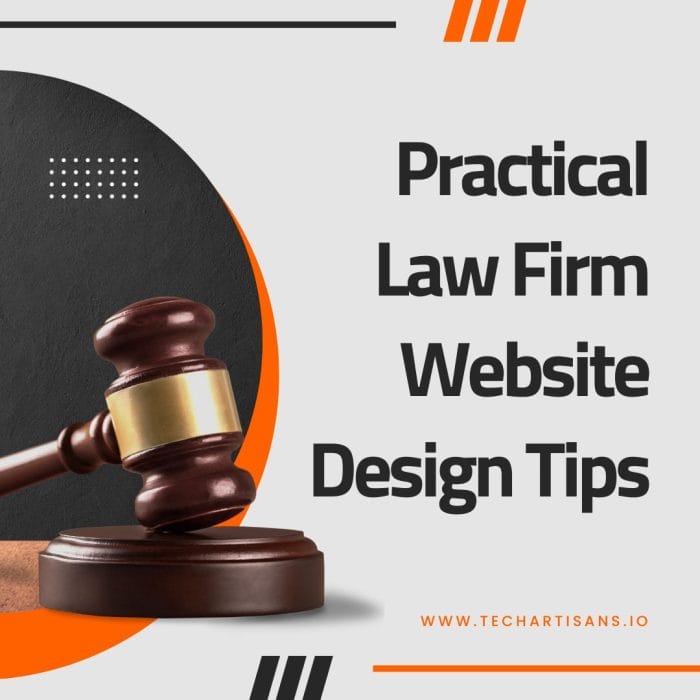In today’s digital age, having a website is important and is often the initial point of contact with potential clients, reflecting your firm’s values, expertise, and professionalism. In this article, I have compiled a list of some practical law firm website design tips to not only enhance your website’s aesthetics but also make it client-centric, engaging, and lead-generating. Read on to learn more about best practices for law firm website design that can set you apart in the crowded legal marketplace.
Practical Law Firm Website Design Tips

Let’s discover actionable and effective strategies for optimizing your law firm’s website design for the success of your business.
1. Web Design Branding

Web design branding conveys a firm’s identity and messages. It’s a visual and conceptual representation of your business online, mirroring your company’s mission, values, and promises. It cultivates an emotional link with your audience; this emotional connection can increase client loyalty, referrals, reputation, and success.
Here are a few tips to align your brand identity with your website’s design to distinguish your law firm in a saturated market.
- Integrate your law firm’s logo and color scheme into your website to promote consistent branding.
- Keep a uniform brand image across all platforms to heighten your firm’s professionalism. Unified branding leads to a cohesive website, offering a smooth user experience.
Read more about the benefits of having a consistent brand identity on your website.
2. User Experience and Navigation

A user-friendly and smooth browsing experience cuts bounce rates and boosts overall user satisfaction turning your site visitors into potential leads. Key elements for easy navigation of the website include well-organized content, clear menus, readily available contact details, an effective search function, and mobile compatibility. Also, a streamlined site structure, fewer clicks to information, and easy access to data enhance the user experience and convert visitors into leads.
Discover the laws of psychology for good UX design.
3. Showcase Achievements and Credentials

Your law firm stands out in a competitive market when you showcase achievements and credentials. These elements build client trust by demonstrating your success, professionalism, and competence.
Also, showcasing each team member’s achievements effectively presents your collective expertise. This approach humanizes your firm, making it relatable. Every member boosts your firm’s credibility, fosters trust, and shows a history of legal excellence.
Learn how to effectively measure your brand awareness.
4. SEO and Content Optimization

Optimizing your law firm’s website content is key for improving online visibility and client acquisition. Search Engine Optimization (SEO) drives potential clients to your website by using strategic keywords and an optimized structure for better visibility on search engine results. Here are a few tips for optimizing your website for search engines.
- Incorporate keywords into your text naturally to boost your site’s visibility in search engines.
- Avoid keyword stuffing and the overuse of keywords to maintain user experience and search engine ranking.
- Use affiliate marketing and backlinking to expand your reach.
- Partner with businesses or influencers to boost your traffic and search engine credibility.
Explore our guide to SEO and responsive web design benefits.
5. Client Testimonials and Success Stories

Trust and reputation are crucial in law firm websites and showcasing client testimonials and success stories on your firm’s website builds that trust and reputation, instilling potential clients’ confidence. It provides an authentic glimpse into your firm’s capability and service quality. Display your firm’s legal skills, achievements, and positive feedback along with past success stories, which are solid evidence of your legal efficacy, to impact potential clients’ views and choices.
Find out how to write effective testimonials.
6. Mobile Compatibility

Your law firm’s website must be mobile-compatible, responsive, and easily accessible on smartphones and tablets to attract more clients. A responsive site adapts to any screen size, ensuring easy navigation and usability. A mobile-friendly site has faster loading times and improved readability on small screens, enhancing user experience. This encourages longer visits, increases client conversions, and boosts your online presence.
Learn more about why having a mobile-compatible website is crucial.
7. Website Speed
Web speed and reactivity are key in crafting an effective law firm website design. Quick loading times are essential to keep visitor attention and lower bounce rates. Discover how to improve your website’s performance and speed.
Slow or unresponsive sites can deter potential clients, impacting your firm’s efficiency perception. Boosting your site’s speed involves utilizing browser caching, image compression, and code-refining strategies. You can use tools like Google PageSpeed Insights or GTmetrix to evaluate your site and give improvement recommendations.
8. Additional Features for Enhanced Engagement

Add more interactive features to your law firm’s website to boost engagement. Here are some ideas for additional features for your site.
- You can incorporate a live chat feature to facilitate immediate communication which will help customers and prompt conversions.
- Build trust with potential clients with videos and virtual tours of your premises and team.
- Include interactive elements such as calculators or quizzes to increase interaction and deliver value.
Explore the importance of web accessibility and its role in enhancing user engagement.
Conclusion
Applying these practical law firm website design tips can significantly enhance your online presence and client engagement. Check out our comprehensive guide on practical law firm website design tips. From avoiding keyword stuffing and implementing effective backlink strategies to showcasing testimonials and ensuring mobile compatibility, every aspect contributes to creating a superior user experience. Prioritize website speed, integrate interactive features, and remember that every detail matters. The end goal is to build trust, and credibility, and foster client relationships, ultimately driving your firm’s success.







